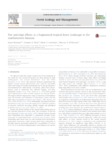Por favor, use este identificador para citar o enlazar este ítem:
http://www.alice.cnptia.embrapa.br/alice/handle/doc/1072940Registro completo de metadatos
| Campo DC | Valor | Lengua/Idioma |
|---|---|---|
| dc.contributor.author | NUMATA, I. | pt_BR |
| dc.contributor.author | SILVA, S. S. | pt_BR |
| dc.contributor.author | COCHRANE, M. A. | pt_BR |
| dc.contributor.author | OLIVEIRA, M. V. N. d' | pt_BR |
| dc.date.accessioned | 2017-07-20T11:11:11Z | pt_BR |
| dc.date.available | 2017-07-20T11:11:11Z | pt_BR |
| dc.date.created | 2017-07-20 | pt_BR |
| dc.date.issued | 2017 | pt_BR |
| dc.identifier.citation | Forest Ecology and Management, Eveleigh, v. 401, p. 135-146, Oct. 2017. | pt_BR |
| dc.identifier.issn | 0378-1127 | pt_BR |
| dc.identifier.uri | http://www.alice.cnptia.embrapa.br/alice/handle/doc/1072940 | pt_BR |
| dc.description | In the southwestern Amazonian state of Acre, intense deforestation in recent decades has madeforests in unprotected areas highly fragmented. This region has also been one of the epicenters of severe drought events in 2005 and 2010, which triggered extensive forest fires across the state. Here, we examine the impacts of forest fire and fragmentation on forest biomass and structure in Acre. | pt_BR |
| dc.language.iso | eng | eng |
| dc.rights | openAccess | eng |
| dc.subject | Fragmentação florestal | pt_BR |
| dc.subject | Borda florestal | pt_BR |
| dc.subject | Idade da borda | pt_BR |
| dc.subject | Acre | pt_BR |
| dc.subject | Western Amazon | pt_BR |
| dc.subject | Amazonia Ocidental | pt_BR |
| dc.subject | Análisis estadístico | pt_BR |
| dc.subject | Bosques tropicales | pt_BR |
| dc.subject | Cubierta vegetal | pt_BR |
| dc.subject | Dinámica poblacional | pt_BR |
| dc.subject | Efectos de borde | pt_BR |
| dc.subject | Fragmentación de hábitats | pt_BR |
| dc.subject | Incendios forestales | pt_BR |
| dc.subject | Inventario forestal | pt_BR |
| dc.subject | Madera tropical | pt_BR |
| dc.subject | Mortalidad | pt_BR |
| dc.subject | Regeneración natural | pt_BR |
| dc.title | Fire and edge effects in a fragmented tropical forest landscape in the southwestern Amazon. | pt_BR |
| dc.type | Artigo de periódico | pt_BR |
| dc.date.updated | 2017-07-20T11:11:11Z | pt_BR |
| dc.subject.thesagro | Floresta tropical | pt_BR |
| dc.subject.thesagro | Essência florestal | pt_BR |
| dc.subject.thesagro | Incêndio florestal | pt_BR |
| dc.subject.thesagro | Impacto ambiental | pt_BR |
| dc.subject.thesagro | Dinâmica populacional | pt_BR |
| dc.subject.thesagro | Mortalidade | pt_BR |
| dc.subject.thesagro | Regeneração natural | pt_BR |
| dc.subject.thesagro | Cobertura vegetal | pt_BR |
| dc.subject.thesagro | Inventário florestal | pt_BR |
| dc.subject.thesagro | Análise estatística | pt_BR |
| dc.subject.nalthesaurus | Tropical forests | pt_BR |
| dc.subject.nalthesaurus | Tropical wood | pt_BR |
| dc.subject.nalthesaurus | Forest fires | pt_BR |
| dc.subject.nalthesaurus | Environmental impact | pt_BR |
| dc.subject.nalthesaurus | Population dynamics | pt_BR |
| dc.subject.nalthesaurus | Mortality | pt_BR |
| dc.subject.nalthesaurus | Habitat fragmentation | pt_BR |
| dc.subject.nalthesaurus | Natural regeneration | pt_BR |
| dc.subject.nalthesaurus | Vegetation cover | pt_BR |
| dc.subject.nalthesaurus | Edge effects | pt_BR |
| dc.subject.nalthesaurus | Forest inventory | pt_BR |
| dc.subject.nalthesaurus | Statistical analysis | pt_BR |
| riaa.ainfo.id | 1072940 | pt_BR |
| riaa.ainfo.lastupdate | 2017-07-20 | pt_BR |
| dc.identifier.doi | 10.1016/j.foreco.2017.07.010 | pt_BR |
| dc.contributor.institution | IZAYA NUMATA, DAKOTA STATE UNIVERSITY | pt_BR |
| dc.contributor.institution | SONAIRA SOUZA DA SILVA, UNIVERSIDADE FEDERAL DO ACRE | eng |
| dc.contributor.institution | MARK ALAN COCHRANE, UNIVERSITY OF MARYLAND | eng |
| dc.contributor.institution | MARCUS VINICIO NEVES D OLIVEIRA, CPAF-ACRE. | eng |
| Aparece en las colecciones: | Artigo em periódico indexado (CPAF-AC)  | |
Ficheros en este ítem:
| Fichero | Descripción | Tamaño | Formato | |
|---|---|---|---|---|
| 26350.pdf | 2,63 MB | Adobe PDF |  Visualizar/Abrir |









